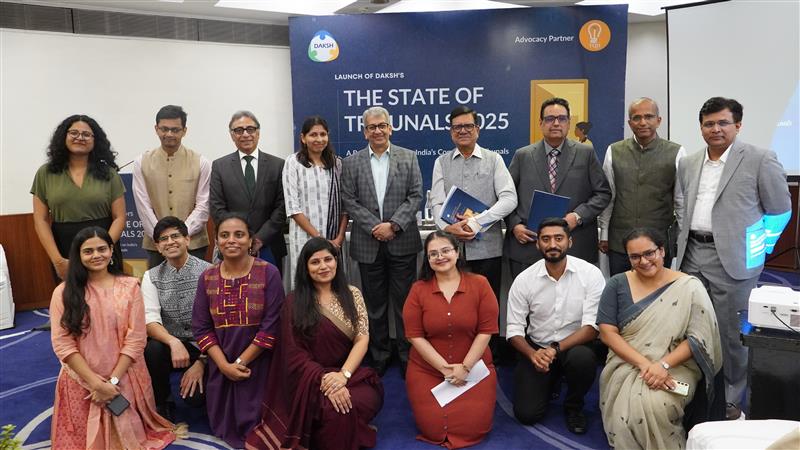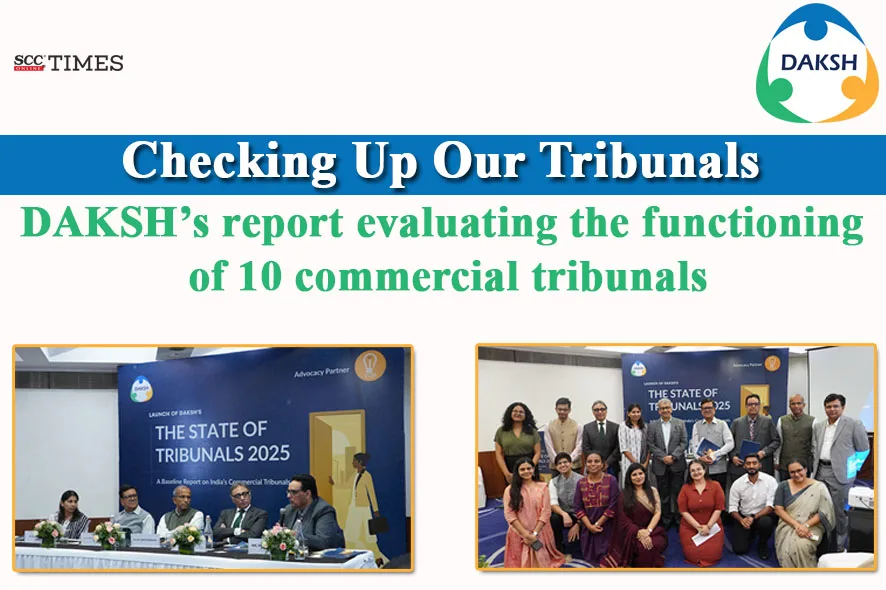On 25-09-2025, DAKSH, a Bengaluru-based civil society organization working on judicial reforms and access to justice, released a report on India’s Tribunals titled “The State of Tribunals Report”, which maps and evaluates the functioning of India’s commercial Tribunals.

Tribunals were introduced in the Indian legal system to provide speedy and specialized dispute resolution. However, in 2024-25, at least ₹24.72 Lakh Crores worth of disputes, i.e., around 7.48% of India’s GDP, remain locked in disputes before key commercial Tribunals. They face mounting challenges, including chronic vacancies, overreliance on contractual staff, jurisdictional overlaps, procedural inconsistencies, and inadequate transparency, which have eroded the promise of efficient adjudication.
The report covers the following major Tribunals of commercial relevance:
-
National Company Law Tribunal (NCLT)
-
National Company Law Appellate Tribunal (NCLAT)
-
Debts Recovery Tribunal (DRT)
-
Debts Recovery Appellate Tribunal (DRAT)
-
Income Tax Appellate Tribunal (ITAT)
-
Customs, Excise and Service Tax Appellate Tribunal (CESTAT)
-
Securities Appellate Tribunal (SAT)
-
Telecom Disputes Settlement and Appellate Tribunal (TDSAT)
-
Appellate Tribunal for Electricity (APTEL)
-
Goods and Services Tax Appellate Tribunal (GSTAT)
The key findings reveal that there are over 3.56 Lakh pending cases across the 10 Tribunals, with DRT/DRAT being on top with 2.15 Lakh pending cases. Furthermore, in 18 States, there is no local DRT, requiring litigants to travel long distances and causing further delay in outcomes.
Apart from such systemic issues, the report found that there is also an infrastructure and technology gap amongst the Tribunals, as some, like the ITAT, provide e-filing and hybrid hearings; others, like the SAT, are housed in rented premises. In fact, parliamentary attention towards Tribunals also varies, with NCLT and DRT receiving high attention while ITAT, SAT, DRAT, and APTEL were neglected. The Tribunals also suffer from inconsistent funding, minimal investment in training and capacity building of the members and staff, and dependence on parent ministries, which limits flexibility in resource allocation.
The report further revealed the following information based on data analysis, legal research, and stakeholder consultations:
-
Despite an increase in workload, there has been no increase in sanctioned strength.
-
There is a deficit of expertise in some Tribunals as the members appointed lack economic and business domain expertise.
-
The Tribunals have poor physical infrastructure that does not reflect the majesty and dignity of institutions that deliver justice.
-
A high number of contractual staff is hampering the efficiency and development of the organization’s culture. E.g., in the NCLT, out of 434 staff members, 382 are on contract and 17 are on deputation.
-
Each Tribunal has a different reporting ministry, which is often in conflict with interest, as they could be parties to the disputes. The Income Tax Appellate Tribunal is the only exception, as its parent department is the Department of Legal Affairs and not the Department of Revenue.
-
Each Tribunal has a different appellate structure. For example, appeals from the DRT go to DRAT and then to the High Courts and then on to the Supreme Court. This defeats the purpose of having a Tribunal for swift adjudication and finality of the case. Some Tribunals have the Supreme Court as their appellate authority, for example, the SAT and NCLAT.
-
In some of the prime Tribunals, like NCLT and NCLAT, most of the members appointed are retired civil servants, public sector bankers, etc., without relevant domain expertise, which goes against the reason for establishing Tribunals. This “dilution of standards” compromises the independence of Tribunals.
-
There is a lack of reliable and comprehensive data on the performance of the Tribunals published by the Tribunals or the concerned Ministries. There remains a striking absence of systematically compiled information on disposal rates, recovery efficiency, bench-wise case pendency, age of cases, etc., for all Tribunals.
After traversing and analyzing the extensive data on each of the Tribunals, the report provides comprehensive solutions ranging from legislative reforms and capacity building to procedural efficiency and governance. It argues that piecemeal fixes are inadequate; instead, reforms must strengthen institutional independence, fill capacity gaps, streamline procedures, and build modern, technology-enabled systems.
Lastly, the report advocates that by treating Tribunals not merely as auxiliary forums but as central to India’s economic governance, the report underscores their role in investor confidence, contract enforcement, and ease of doing business, making Tribunal reform a strategic national priority.
To read the full report, click HERE.




I will give specific case details where there is sheer abuse of process of the Law
Can I get your help and involvement in the malicious functioning of the courts